#Octocorals
Text
A gorgonian fit for novice reefers?
The gorgonians, a subclade of the octocorals or soft corals, have a reputation as difficult to care for, in the reef aquarium. Such a reputation is partly deserved, since many colonies that are imported, represent species that lack photosynthesizing symbionts. Therefore feeding them sufficiently, dosing an appropriate food, and yet not overburdening the filtration system, together form a challenge. Yet there are also non-photosynthetic alcyonarian colonies, that are notoriously challenging to care for. And this fact has not simi larly tainted all of their alcyonarian cousins, with a reputation as overly difficult to maintain alive.
The purple bush gorgonian, as it is traded, is known to marine biologists as Muriceopsis flavida. It is known to divers as the rough sea plume, and Lamarck's Muriceopsis. This species grows in clear, shallow subtital habitats, primarily on patch reefs, primarily in the Caribbean. Records however exist, from as far south as Brazil, so the correct distribution, should be described as tropical Western Atlantic. Wild colonies grow to 75 centimeters or 30 inches tall, and take a bushy, plume-like growth habit. From long main branches, sometimes bearing secondary plumes, M. flavida sprouts stout, stiff pinnules or branchlets, 5 to 8 centimeters long, or from 2 to just exceeding 3 inches. The coloration of a colony may be too pale or dark, to be described as purple, but it is the purple form that is exported for the trade, and aquaculture. Colonies in the wild, are usually no higher than 50 centimeters, or 20 inches.
Because M. flavida relies on photosynthetic symbiotes for a good proportion of its energy needs, sustaining this octocoral is less of a challenge, than the asymbiotic red and yellow Acabaria gorgonians, that too often have short lifespans in our tanks. M. flavida appreciates moderate to high lighting and flow. The latter should be enough to sway the gorgonian in the current, bringing in food and sweeping away wastes. Yet it need not be too intense either. M. flavida is actually reasonably adaptable, it has been noted, to a number of aquarium conditions, and is therefore a good choice of coral for outright beginners.
#Muriceopsis flavida#Purple bush gorgonian#Rough sea plume#Lamarck's Muriceopsis#corals for beginners#aquarium corals#Octocorals#Gorgonians
0 notes
Note
a bit late bc time zones, can i still get a trick or treat about corals?
Yes! Please just hurry and grab some of the sea pens (which are a type of octocoral) down at the bottom before this Tritonia sea slug gets them (sea pens are also their favorite treat)!

Video ID: Fifish ROV footage with labels showing it is a dive on July 8th 2023 at a depth of about 47 feet. There are several tall orange sea pens poking out of the sandy bottom and some long fish. We zoom around to look at a few different ones. Up close to them you can see there's a bit of a bulbous buried part that looks kind of like a carrot and then a big billowy feathery part sticking out thats made up of little tiny zooids.
#trick or treat#my videos#my marine biology videos#sea pen#octocoral#soft coral#salish sea#burrows bay#fifish#ROV#marine life#sea creatures#marine biology#science communication#my sci comm#ask and i shall infodump
29 notes
·
View notes
Text
youtube
DND OC ANIMATIC! for octo my beloved
#animatic#dnd#my art#sufjan stevens#fourth of july#I SPENT LIKE A MONTH ON THIS. I'M GOING INSANE#i miss octo so so bad#octocore#OCTOOOO#Youtube
7 notes
·
View notes
Photo
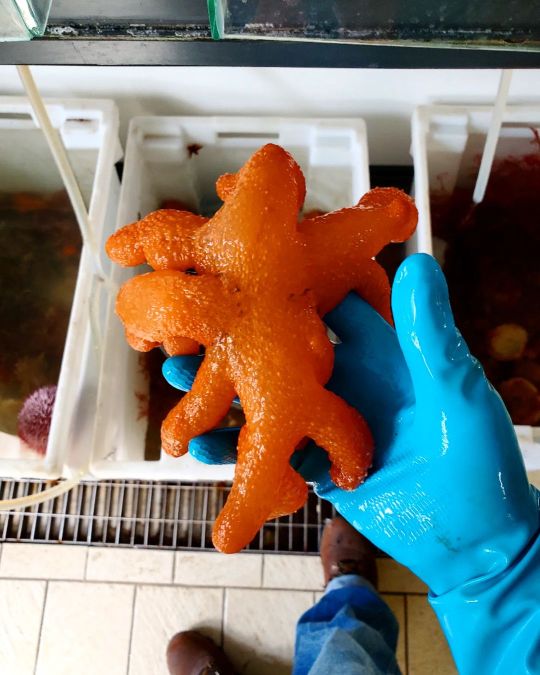
Taken the same day as the previous post, this is a dead man's fingers (Alcyonium digitatum), or död mans hand. In Sweden, they occur on the west coast within the sub-littoral zone, wherever there is strong water flow, attached to rocks, shells, and stones in areas uninhabitable for algae forming whole colonies, even occasionally on crabs and gastropods. Because of their dark environments, these corals don't feed with zooxanthellate and instead feed on plankton. #animal #animals #djur #wildlife #natur #naturliv #nature #invertebrate #invertebrates #octocoral #fauna #coral #corals #koralldjur #softcoral #softcorals #hornkorall #hornkoraller #cnidarian #cnidarians #animalia #cnidaria #octocorallia #alcyonacea #alcyoniidae #alcyonium #alcyoniumdigitatum #deadmansfingers #dödmanshand (at Klubbans biologiska station) https://www.instagram.com/p/CeI7qp5q5m3/?igshid=NGJjMDIxMWI=
#animal#animals#djur#wildlife#natur#naturliv#nature#invertebrate#invertebrates#octocoral#fauna#coral#corals#koralldjur#softcoral#softcorals#hornkorall#hornkoraller#cnidarian#cnidarians#animalia#cnidaria#octocorallia#alcyonacea#alcyoniidae#alcyonium#alcyoniumdigitatum#deadmansfingers#dödmanshand
0 notes
Note
woag, more sea slug lovers!!! <3
could you show the world phyllodesmium poindimiei, it's really beautiful
according to wikipedia it's also called spun of light which is such a pretty name, but sadly that claim is unsourced and I can't find the name anywhere else (except for copies from wikipedia) 😔
Latin name: Phyllodesmium poindimiei
Common name: Spun Of Light
Family: Myrrhinidae
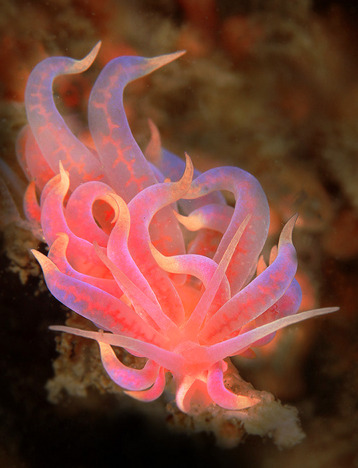
We couldn't find another name :(
I think 'Pink octoslug' could sound cool :D
🌐 Spread sporadically along tropical coastal regions such as Australia, Hawaii, and the Indo-Pacific. Mostly coral reef marine habitats.

🍽 Very picky eaters. They feed on Telesto, Caridoa, and other Alcyonaceans. Their prefered food is Carijoa, a soft coral.

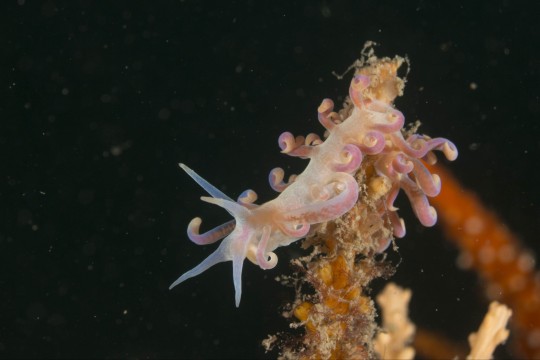
💫 Their ceratas are for defensive purposes, not just for capture and release of toxins.

💫 These slugs are nocturnal. Hiding under the corals during the day, coming out during the night to feedon said corals.
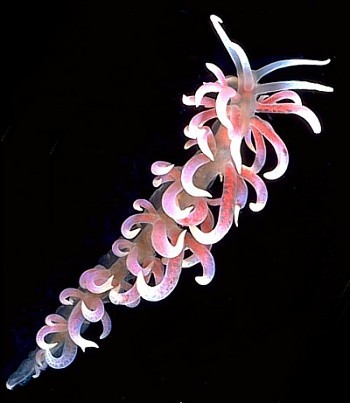
🦠 They are often used as a determinant for climate changed, due to them being reliant on the octocorals they feed on. Through these changes they evolve and thrive. It also activly helps us!
We apologize for such a long wait! It is the exam season before holidays, so we will update whenever we can. :')
We thank you for the ask! (If there are any mistakes, please, don't be afraid to DM! We might have read the information wrong or even misunderstood.)
#sea slug#seaslug haven#deep sea#marine animals#marine life#nature#nudibranch#ocean#marine biology#seaslug#8.12.2023#spun of light#Phyllodesmium poindimiei#pink octoslug#Myrrhinidae
241 notes
·
View notes
Text
Shining a light on the origins of bioluminescence ✨✨
A new study led by MBARI collaborators at the Smithsonian’s National Museum of Natural History explores the evolution of bioluminescence, nature’s living light show. A team of researchers, including MBARI Senior Scientist Steven Haddock, has learned bioluminescence first evolved in animals at least 540 million years ago in soft corals.
Scientists have long been curious about the evolution of bioluminescence. To tackle the larger question of why bioluminescence evolved, we needed to know when this ability first appeared in animals. In search of the trait’s earliest origins, the team decided to peer back into the evolutionary history of octocorals, an ancient and frequently bioluminescent group of animals that includes soft corals, sea fans, and sea pens.
Mapping out the branches of the evolutionary tree from fossil records, genetics, and bioluminescent behaviors revealed that some 540 million years ago, the common ancestor of all octocorals was very likely bioluminescent. That is 273 million years earlier than the glowing ostracod crustaceans that previously held the title of earliest evolution of bioluminescence in animals.
MBARI’s Biodiversity and Biooptics Team is working to understand how and why animals produce their stunning luminescence.
Learn more about this illuminating research on our website.
142 notes
·
View notes
Text

Speechless. Just speechless.
Who loves our new 50th Anniversary #SaveSpectacular of Flower Garden Banks National Marine Sanctuary? 😍
NOAA's Flower Garden Banks National Marine Sanctuary encompasses 17 reefs and banks located approximately 80–125 miles off the Texas and Louisiana coasts. These banks are a combination of small underwater mountains, ridges, troughs, and hard-bottom features formed as a result of dynamic salt domes beneath the seafloor. The habitats associated with these banks range from thriving coral reefs and coral communities, to deeper mesophotic reefs filled with black corals, octocorals, algal nodules, and sponges. These varied habitats provide havens for reef fish and invertebrates, as well as manta rays, sea turtles, and sharks.

Take a look for yourself, and download the poster today!
🎨: Kathryn Robertson, Matt McIntosh/NOAA, and Melissa Cook
#FlowerGardenBanks#Texas#Louisiana#MarineLife#CoralReef#GraphicDesign#Art#Illustration#DigitalArt#ocean#noaa#earthisblue#national marine sanctuary#science#nature#conservation
34 notes
·
View notes
Photo
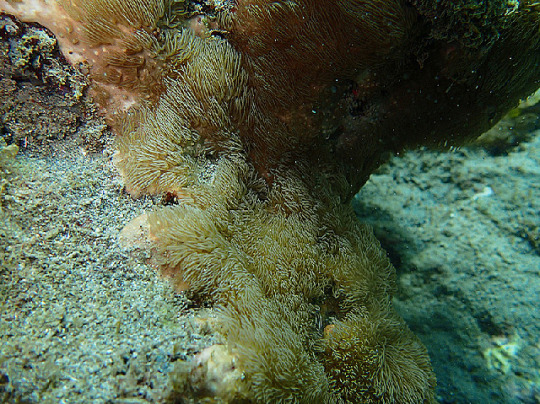
Cancer-crushing Corals
From fluorescent jellyfish proteins to drug-inspiring cone snail toxins, marine animals are a biomedical treasure trove. Soft corals and their relatives, collectively known as octocorals, possess a vast library of particularly promising compounds, diterpenes, currently under investigation as potential drugs. Yet, with little understanding of how they are produced, synthesising them in the laboratory has proved difficult, hindering progress. In a recent breakthrough, researchers identified a cluster of genes involved in the synthesis of eleutherobin, a coral diterpene with potent anti-cancer activity, in the genome of the soft coral Erythropodium caribaeorum (pictured). Unlike in many marine animals, eleutherobin is not produced by a bacterial symbiont, a microbial partner living within the coral, but by the coral itself, and similar genes exist in other octocoral genomes, suggesting that diterpene production is an ancient adaptation. Elucidating this genetic pathway provides key tools for making coral diterpenes, boosting their potential for drug development.
Written by Emmanuelle Briolet
Image by Naturalis Biodiversity Center
Research by Paul D. Scesa, Zhenjian Lin & Eric W. Schmidt, Department of Medicinal Chemistry, University of Utah, Salt Lake City, UT, USA
Image originally published with a Attribution-NonCommercial-ShareAlike 3.0 Unported (CC BY-NC-SA 3.0) license
Research published in Nature Chemical Biology, May 2022
You can also follow BPoD on Instagram, Twitter and Facebook
#science#biomedicine#cancer#cancer drugs#oncology#tumours#drug development#coral#diterpenes#soft coral#marine life#anti-cancer drugs
130 notes
·
View notes
Text


Phyllodesmium is a species of aeolid nudibranchs; of which tend to be and this species IS --- marine gastropod molluscs. These are in the family Facelinidae.
These beautiful nudibranchs have tendril-like appendages on their thin body and as you can see are soft-bodied nudibranchs similar to most other species.
They come in different variations; from non-transparent to transparent, with transparent offspring being called Phyllodesmium opalescens, Phyllodesmium iriomotense, Phyllodesmium poindimiei and other terms. Non-transparent versions of this genus are called Phyllodesmium briareum, Yellow-tipped phyllodesmium, Phyllodesmium serratum and other terms likewise.
These are one of the more uncommon species, as these tendrils encompass their entire body. Its prey are octocorals; a kind of soft coral, and Some of the species are also unusual in that they are able to utilize zooxanthellae from their prey, in a symbiotic relationship that provides them with extra nutrition from photosynthesis, hence they are commonly called "solar-powered" sea slugs.
────────────────────────────────────────────
⇾ Follow my page for more epic, silly and boomblu content; share so I can grow if you wish, and come visit my other socials at my Linktree [Just click the word Linktree, it's hyperlinked :)]. ⇽
Check out the rest of my posts too!!! A lot of them are underrated. ;o Like everything you find interesting if you want. :3
Remember, you can find all of my socials here (click the word [here], it's hyperlinked (。◕‿‿◕。) For the plain link; here it is: https://lynkfire.com/Gliphel&Glyph%20LLC%20Incorperated
Also; if you prefer Linktree, it's here.
#aquatic#aquatic life#sea creatures#fish#marine lifeseas#sea animals#sea life#sea#ocean#seaside#seascape#marine#marine biology#marine life#nudibranch#nudibranchs#molluscs#aesthetic#aesthetics#aestethic#aestheitcs
12 notes
·
View notes
Text
Octocore

#twisted wonderland#twst meme#twisted wonderland floyd#twisted wonderland jade#twisted wonderland azul#azul ashengrotto
144 notes
·
View notes
Text
Organ pipe coral, soft yet stony?
One of the oddest octocorals, is the organ pipe coral, Tubipora musica. Technically T. musica may be a species complex, and if zoological naming standards were upheld, T. musica would then become a nomen nudum, because its type material cannot be designated to any species within its own species complex. This kind of dilemma more often affects paleontologists, than those working with extant animals. But it has the same cause - Linneaus used ambiguous skeletal material for the holotype, without knowledge of the traits useful in discerning closely related species.
T. musica colonies are rounded and may grow to 3 meters or 110 inches across, but the living polyps are small in diameter when they are extended. This coral has a stony skeleton composed of calcium carbonate, that is a vivid red (or sometimes violet) in color, and the form of many vertical tubes, resembling the pipes of a church organ. Each tube houses a Tubipora polyp, and in life the cream to green or brown colored polyps, mask the color of the colonial skeleton. Each polyp possesses eight, rather than six tentacles, the number and pennate form of which, identify the skeleton maker as an octocoral, or soft coral, rather than one of the scleractinian or stony corals that it mimics.
Tubipora grow in shallow, sheltered situations, from East Africa to the West Pacific, in shallow waters from 2 to 20 meters in depth. Seemingly they are commonest between 8 and 10 meters down, where they can be locally dominant over sympatric scleractinians. Like reef building stony corals, T. musica accommodates symbiotic dinoflagellates within its own living tissues. These are photosynthetic, microscopic organisms, that provide energy for their host, in exchange for shelter in its tissues - a true example of symbiosis on the reef. Tubipora itself also obtains nutrients from dissolved organic matter in the surrounding water, and is an effective predator of bacteria. Octocorals as a whole, are inefficient at feeding on animal plankton, or at heterotrophic feeding more generally, explaining why they are outnumbered on the reef by their scleractinian rivals. Of the octocorals, Tubipora is one of the better competitors, against the more diverse scleractinians.
In the reef aquarium, Tubipora appreciates average lighting, and a brisk water flow. The Tubipora skeleton has all types of nooks that allow detritus to accumulate. Too much of this accumulation, can lead to detritus build up suffocating the polyps that inhabit the skeleton, so it's important that flow passes through. This flow should not, however, be laminar, and if the flow is too strong, Tubipora colonies will fail to extend and feed. These are not difficult corals to care for, although like scleractinians, their presence and growth in the aquarium, creates demands for water chemistry to be maintained. This is because the polyps of skeletonised anthozoans, absorb minerals from seawater to secrete their skeletons. In this sense, caring for Tubipora actually is more like caring for scleractinian corals, than an ordinary octocoral. Also note that colonies collected by detachment from larger colonies, are not expected to survive in the aquarium. Healthy Tubipora colonies, are imported as attached already to a base rock.
0 notes
Text

Iridogorgia, a chrysogorgid octocoral
via NOAA
7 notes
·
View notes
Photo
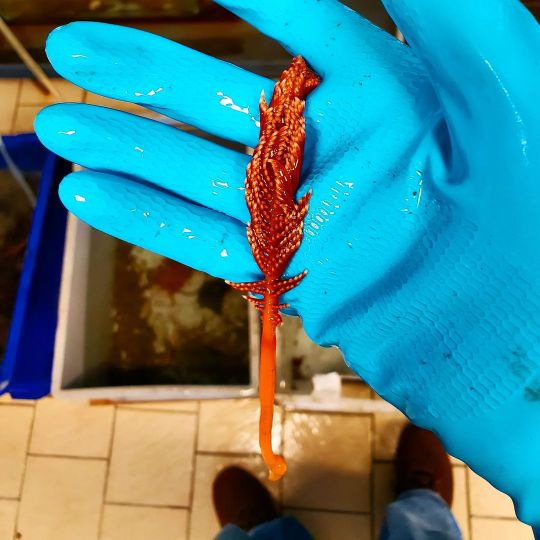
Taken the same day as the previous post, this is a phosphorescent sea pen (Pennatula phosphorea), or röd fjäderpenna, found in the fjord. It clearly wasn't in it's preferred living situation where the basal peduncle is buried in soft sediment while the branches filter for food. I was unable to see the bioluminescence this species exhibits, but I was able to feel is that the sea pen's fleshy mass is supported by an internal rod made of calcium carbonate. #animal #animals #djur #wildlife #natur #naturliv #nature #invertebrate #invertebrates #octocoral #fauna #sjöpenna #sjöpennor #seapen #seapens #nässeldjur #cnidarian #cnidarians #animalia #cnidaria #anthozoa #octocorallia #pennatulacea #pennatulidae #pennatula #pennatulaphosphorea #phosphorescentseapen #rödfjäderpenna (at Klubbans biologiska station) https://www.instagram.com/p/CeHJFPpKisO/?igshid=NGJjMDIxMWI=
#animal#animals#djur#wildlife#natur#naturliv#nature#invertebrate#invertebrates#octocoral#fauna#sjöpenna#sjöpennor#seapen#seapens#nässeldjur#cnidarian#cnidarians#animalia#cnidaria#anthozoa#octocorallia#pennatulacea#pennatulidae#pennatula#pennatulaphosphorea#phosphorescentseapen#rödfjäderpenna
1 note
·
View note
Text
@nejinrou on twitter / previously @octocore

#this account is a work in progress#but i thought id share so i can reconnect with mutuals!#welcome :)
26 notes
·
View notes
Photo

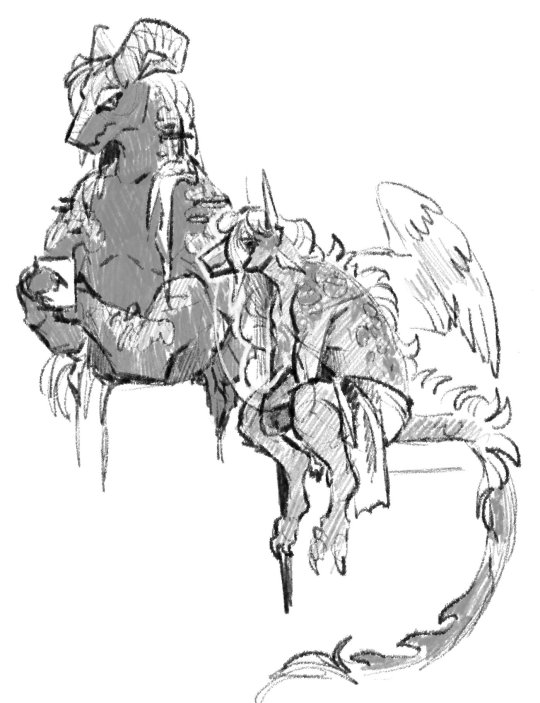
ell @octocore also gave me permission to furryify the little guys
71 notes
·
View notes
Text
Side Order of Coral
Some random information on corals that may or may not relate to the Splatoon 3 DLC (Side Order)! We don’t have any real idea what the story is going to be about, but I guess it can be food for thought. Included pictures from the trailer and corals, so it got a little long...
Under the cut it goes!
First, all corals are made up of polyps; the majority of these tiny organisms make an exoskeleton at their base made of calcium carbonate. They’re actually related to jellyfish and anemones! Most corals are a colonial organism, meaning they are made up of hundreds to hundreds of thousands of polyps living in a group. There are two main sub-classes of coral, depending on how many tentacles each polyp has; six (Hexacorallia) or eight (Octocorallia). Hexacorallia includes the hard corals, while Octocorallia includes the soft. Most corals can photosynthesize, but they also eat plankton or small animals that get stung by the nematocysts on the polyps’ tentacles, in the same manner as jellyfish. Feeding usually happens at night when the polyps stick out of their pockets in the body of the coral.
When you think “coral”, you probably think of colorful coral reefs. Most of these types get their colors from a type of symbiotic organism called “zooxanthellae”! They live with the coral, inside the tissues of the polyps, where they’re protected and thereby able to photosynthesize. The largest part of the nutrients produced by the zooxanthellae’s photosynthesis (almost 90%) is taken in by the coral, and allows the polyps to grow and reproduce, expanding the coral reef. However, most of the corals we saw in the trailer are bleached; this can happen for a variety of reasons, such as pollution, rising water temperatures, or other stress on the coral, which causes the polyps to expel the zooxanthellae and lose their color. If they go long enough without their zooxanthellae, the coral eventually dies.

[Image of the main Octoling standing in a strange, white Inkopolis Square. The coral in the background is bleached and crumbling.]
When a coral dies, it leaves behind its skeleton. This skeleton is covered in tiny holes, showing where the polyps used to be.
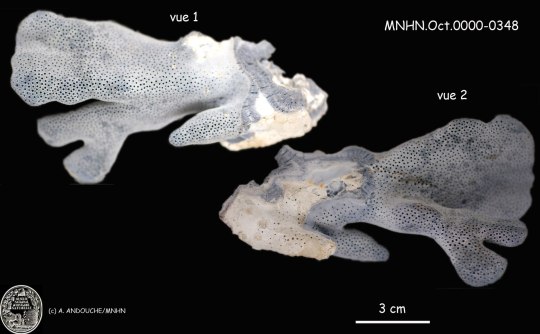
[Image of a blue coral skeleton, covered in little holes the polyps used to live in. Blue coral is the only octocoral known to form a stony body.]
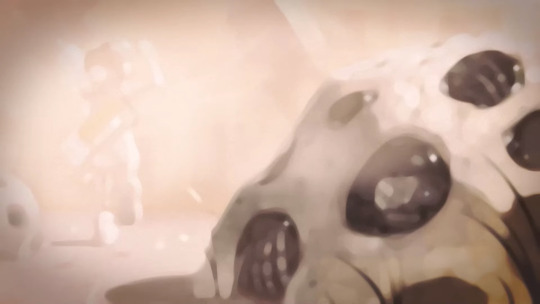
[Image from the SO trailer; foreground object looks like a skull, but with far too many holes. Possible coral skeleton.]
Slight side note, but as anemones also get their colors from their zooxanthellae, I thought it was interesting that Annie (in Inkopolis Plaza) also appears to be losing her color. Her hair is much paler than it was in the first game, suggesting the effects we see in Side Order may be making their way around...

[Image comparing Annie in Cooler Heads from the first game (left) to the thrid game’s DLC (right).]
Onto coral types! Stony corals, as the name would suggest, build themselves a hard skeleton. These are the types that form the coral reefs, and come in a huge variety of shapes and sizes. They tend to prefer nutrient-poor water with access to lots of sunlight, relying on their zooxanthellae for a large portion of their nutrients. The majority of stony coral polyps are Hexacorallia, meaning their polyps have six tentacles each. We saw at least one hard coral in the trailer; the brain coral! As the name suggests, they have a winding growth pattern that makes their surface look like a brain. We’ll get back to this in a moment!

[Image of a type of bleached brain coral]

[Image of the brain-like object (probably coral) from the SO trailer]
Soft corals, for the most part, do not form a rigid skeletal structure. They tend to form a tougher core with a fleshy exterior for protection, and as a result are more flexible than stony corals. The are also colonial, but don’t form reefs; however, they are still part of the reef ecosystem. Some types can also survive and thrive in the deep sea, getting their nutrients by filter feeding as they sway in the current instead of zooxanthellae. All soft coral polyps are Octocorallia, as they have eight tentacles.
This, of course, could have a potential connection to another eight-tentacled someone who happened to spend some time in the Deepsea...
Returning to our brain coral thought; corals also have their own nervous system! Their nervous system is of the most simple type, lacking a brain, and is referred to as a “nerve net”. This net connects all the polyps, allowing them to transmit impulses in any direction; it is also what allows anemones and jellyfish to swim, though slowly and largely at the mercy of the current. Further, the nerve net of cnidarians (corals, jellyfish, anemones, etc.) is thought to be the evolutionary precursor to bilaterian nervous systems; those involving a central nervous system with a brain. There are a few instances of nerve-like images, which also bear resemblance to some types of sea fan (a soft coral), and could tie into a potential “experiment”-based story line (similar to Octo Expansion).

[Image from Side Order trailer; pink lines creep down the white walls and over the black ground in a similar manner to veins or nerves.]
Finally, polyps reproduce either sexually (via spawning) or asexually, budding off clones of themselves to grow their main body/skeleton. Cloning can also happen with fragmentation, when a chunk of the coral is broken off by a storm/etc., and the colony begins to from a separate colony. As we saw clones in the trailer, this ties in nicely to our ongoing coral theme.

[Image of what appears to be clones of the main Octoling; the ones farther back are bleached.]
We don’t yet know what this DLC is going to be about, but coral, and coral imagery, features heavily in the trailer. All of it is dead.
Sources: [1], [2], [3], [4]
#splatoon#splatoon 3#side order (splatoon)#octoling#agent eight#agent 8#it's coral time babeyyyy#there were a few times I wanted to speculate about what it could mean#but i felt like sticking with just information might be best#if you have any spec thoughts please drop them on me tho!!#or don't and make a separate post i lurk in the tag sometimes#annie (splatoon)
19 notes
·
View notes